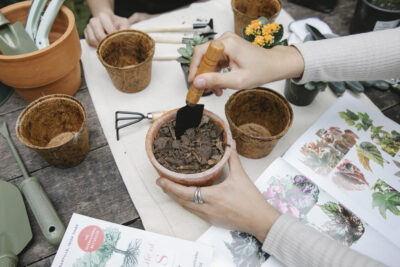
Avoiding Overwatering: Essential Tips for Proper Succulent Care

Overwatering is one of the most common mistakes made when caring for succulents. These unique plants have adapted to thrive in dry and arid conditions, making them highly susceptible to root rot and other issues caused by excessive moisture. To ensure the health and longevity of your succulents, it is crucial to understand the proper watering techniques and to be aware of the signs of overwatering.
We will delve into the world of succulent care and provide essential tips on how to avoid overwatering. We will explore the reasons why succulents are prone to overwatering, discuss the signs and symptoms of overwatering, and provide guidance on establishing a suitable watering schedule. Additionally, we will share practical advice on how to properly water and drain your succulents, as well as tips for creating well-draining soil and choosing the right pots. By following these tips, you will be equipped with the knowledge and tools necessary to keep your succulents thriving and looking their best.
- Water succulents sparingly to avoid overwatering
- Allow the soil to dry completely between watering sessions
- Use well-draining soil specifically designed for succulents
- Ensure that the succulent is planted in a pot with drainage holes
- Adjust watering frequency based on the season and climate
- Use a watering method that allows for precise control, such as a watering can with a narrow spout
- Monitor the leaves and roots for signs of overwatering, such as yellowing leaves or rotting roots
- Provide adequate sunlight to help the succulent dry out between watering
- Consider using a moisture meter to gauge the soil's moisture level before watering
- Be cautious of using a spray bottle to mist succulents, as it can lead to overwatering
- Frequently Asked Questions
Water succulents sparingly to avoid overwatering
Overwatering is one of the most common mistakes that succulent owners make, often leading to root rot and other plant health issues. To prevent this, it is crucial to water succulents sparingly and follow proper care guidelines. Here are some essential tips to avoid overwatering your succulents:
1. Understand the water needs of your succulents
Succulents are desert plants that have adapted to survive in arid conditions. They store water in their leaves, stems, and roots, allowing them to withstand long periods of drought. Therefore, they do not require frequent watering like other houseplants. It is important to research and understand the specific water needs of the succulents you own.
2. Check the soil moisture before watering
Before reaching for the watering can, always check the moisture level of the soil. Succulents prefer well-draining soil, so it should be slightly dry before watering again. Stick your finger about an inch into the soil; if it feels dry, it's time to water. However, if it still feels moist, hold off on watering for a few more days.
3. Water deeply but infrequently
When it's time to water, make sure to give your succulents a thorough soak. Water the soil until it is saturated, allowing excess water to drain out of the pot. However, do not water again until the soil has completely dried out. This mimics the natural rainfall patterns that succulents experience in their native habitats.
 The Best Way to Water Succulents: Top or Bottom?
The Best Way to Water Succulents: Top or Bottom?4. Use the "soak and dry" method
The "soak and dry" method is a popular watering technique for succulents. It involves thoroughly watering the plant and allowing the soil to dry out completely before watering again. This method promotes healthy root growth and prevents the risk of overwatering.
5. Avoid water accumulation in the pot
Ensure that your succulent pots have drainage holes to prevent water from accumulating at the bottom. Excess water in the pot can lead to root rot and other fungal diseases. If your pots don't have drainage holes, consider transferring your succulents to pots that do.
6. Adjust watering frequency based on seasons
Succulents have different water requirements during different seasons. In the growing season (spring and summer), they may need more frequent watering due to increased growth. However, in the dormant season (fall and winter), they require less water as their growth slows down. Adjust your watering frequency accordingly to prevent overwatering.
By following these essential tips, you can ensure the proper care and health of your succulents while avoiding the common mistake of overwatering. Remember, less is often more when it comes to watering these resilient plants.
Allow the soil to dry completely between watering sessions
Proper watering is crucial for the health and longevity of your succulents. Overwatering is one of the most common mistakes made by succulent enthusiasts, as these plants are adapted to survive in dry conditions. To avoid overwatering, it is essential to allow the soil to dry completely between watering sessions.
Succulents store water in their leaves, stems, and roots, which allows them to thrive in arid environments. They have the ability to withstand periods of drought and can survive with minimal watering. Therefore, it is important to mimic their natural habitat when caring for them at home.
 Can Ice Cube Succulents effectively hydrate your plants?
Can Ice Cube Succulents effectively hydrate your plants?One way to determine if it's time to water your succulents is by checking the moisture level of the soil. Stick your finger about an inch into the soil; if it feels dry, it's time to water. If the soil feels moist or damp, it means that the plant still has enough water and you should wait before watering again.
Another useful tip is to use a well-draining soil mix specifically formulated for succulents. This type of soil allows excess water to drain quickly, preventing the roots from sitting in water and potentially rotting. A well-draining soil mix combined with proper watering practices will help your succulents thrive.
Remember, it's better to underwater your succulents than to overwater them. These resilient plants can tolerate dry conditions, but they are highly susceptible to root rot caused by overwatering. By allowing the soil to dry completely between watering sessions, you'll be providing your succulents with the optimal conditions they need to flourish.
Use well-draining soil specifically designed for succulents
One of the most important factors in preventing overwatering is using the right type of soil for your succulents. Regular potting soil tends to retain moisture, which can lead to root rot and other issues for these desert plants. Instead, opt for well-draining soil specifically designed for succulents.
This type of soil is usually a mix of materials such as sand, perlite, and peat moss, which helps to promote proper drainage and prevent water from sitting around the roots. It allows excess water to flow out of the pot, keeping the roots dry and reducing the risk of overwatering.
Avoid frequent watering
Succulents are adapted to survive in arid conditions, which means they don't require frequent watering like other houseplants. In fact, overwatering is one of the most common mistakes made by succulent owners.
 Watering Succulents: Frequency and Amount to Keep Them Thriving
Watering Succulents: Frequency and Amount to Keep Them ThrivingIt's important to establish a watering routine that allows the soil to dry out completely between watering sessions. Typically, succulents only need to be watered once every 1-2 weeks, depending on the climate and humidity levels in your area.
Before watering your succulents, always check the moisture level of the soil. Insert your finger about an inch deep into the soil – if it feels dry, it's time to water. If it still feels moist, wait a few more days before watering.
Provide proper drainage for your pots
In addition to using well-draining soil, it's crucial to ensure that your pots have adequate drainage. Succulents dislike sitting in stagnant water, as it can lead to root rot and other complications.
Choose pots with drainage holes at the bottom to allow excess water to escape. If you have decorative pots without drainage, consider using a nursery pot with drainage and placing it inside the decorative pot. This way, you can easily remove the inner pot to empty any excess water after watering.
Pay attention to the signs of overwatering
To avoid overwatering, it's essential to pay attention to the signs that your succulents may be getting too much water. Some common indicators include yellowing or mushy leaves, wilting, and a foul smell coming from the soil.
If you notice any of these signs, it's crucial to adjust your watering routine immediately. Allow the soil to dry out completely before watering again and consider reducing the frequency of watering.
Remember, less is more when it comes to watering succulents. By using well-draining soil, establishing a watering routine, providing proper drainage, and being attentive to signs of overwatering, you can ensure the health and longevity of your succulent collection.
 Balancing Watering for Healthy Succulents
Balancing Watering for Healthy SucculentsEnsure that the succulent is planted in a pot with drainage holes
Proper drainage is crucial for succulent care as these plants are highly susceptible to root rot caused by overwatering. To avoid this, it is essential to plant your succulent in a pot with drainage holes. These holes allow excess water to escape, preventing water from pooling at the bottom of the pot and drowning the roots.
When selecting a pot for your succulent, opt for one made of a porous material like terracotta or ceramic. These materials allow water to evaporate more easily, ensuring that the soil does not become waterlogged. Additionally, consider choosing a pot that is slightly larger than the plant's root system to allow for growth.
Tip: If you have a pot that lacks drainage holes, you can create them yourself by using a drill or adding a layer of rocks or pebbles at the bottom of the pot to create a reservoir for excess water.
Adjust watering frequency based on the season and climate
When it comes to succulent care, one of the most common mistakes is overwatering. Succulents are desert plants that have adapted to survive in arid conditions, so they are not accustomed to receiving excessive amounts of water. To ensure the health and longevity of your succulents, it is essential to adjust your watering frequency based on the season and climate.
1. Understand the watering needs of your succulents
 Succulent Soil: The Ultimate Home Growing Guide
Succulent Soil: The Ultimate Home Growing GuideBefore you start watering your succulents, it is crucial to understand their specific watering needs. Succulents have thick, fleshy leaves that store water, allowing them to withstand long periods without moisture. As a general rule, succulents prefer to be slightly underwatered rather than overwatered.
2. Consider the season
The watering requirements of succulents can vary depending on the season. During the spring and summer months, when temperatures are higher and the days are longer, succulents typically have increased growth and water needs. In contrast, during the fall and winter months, succulents enter a period of dormancy and require less water. Adjust your watering schedule accordingly.
3. Take into account the climate
The climate in which your succulents are located also plays a crucial role in determining their watering needs. If you live in a dry, arid climate, your succulents will require more frequent watering compared to those living in a more humid environment. Be mindful of the humidity levels and adjust your watering frequency accordingly.
4. Check the soil moisture
A reliable way to determine if your succulents need water is to check the moisture level of the soil. Stick your finger about an inch into the soil – if it feels dry, it is time to water your succulents. However, if the soil feels damp or moist, it is best to hold off on watering to prevent overwatering.
 Optimal Soaking Time for Succulents: How Long Before Planting
Optimal Soaking Time for Succulents: How Long Before Planting5. Use well-draining soil and containers
Proper soil and container selection can also contribute to avoiding overwatering. Succulents thrive in well-draining soil that allows excess water to flow out easily. Additionally, choose containers with drainage holes to prevent water from pooling at the bottom and potentially drowning the roots of your succulents.
By adjusting your watering frequency based on the season and climate, understanding the watering needs of your succulents, and using well-draining soil and containers, you can effectively avoid overwatering your succulents. Remember, a little bit of research and attention to detail can go a long way in maintaining the health and beauty of your succulent collection.
Use a watering method that allows for precise control, such as a watering can with a narrow spout
When it comes to caring for succulents, one of the most common mistakes people make is overwatering. These resilient plants are adapted to survive in arid climates and store water in their leaves, stems, and roots. Therefore, it's crucial to follow proper watering techniques to avoid drowning your succulents.
Choose the Right Watering Method
Using a watering can with a narrow spout is an excellent choice for watering succulents. This method allows for precise control over the amount of water you pour, reducing the risk of overwatering. The narrow spout ensures that water is directed only to the base of the plant, avoiding wetting the leaves excessively.
Water Sparingly
Succulents have adapted to survive in dry conditions by storing water in their leaves and stems. Therefore, they don't require frequent watering like other houseplants. To prevent overwatering, water your succulents sparingly. A general rule of thumb is to allow the soil to dry out completely before watering again. This ensures that the plant's roots have a chance to breathe and prevents root rot.
Check the Soil Moisture
It's essential to monitor the moisture level of the soil before watering your succulents. Stick your finger about an inch into the soil to check for dampness. If the soil feels moist, it means it still has enough water, and you should wait a few more days before watering. However, if the soil feels dry, it's time to water your succulents.
 Succulents: Watering Necessity or Thriving Without?
Succulents: Watering Necessity or Thriving Without?Use Well-Draining Soil
Choosing the right soil for your succulents is crucial in preventing overwatering. Opt for a well-draining soil mix specifically designed for succulents. This type of soil allows excess water to drain quickly, preventing water from accumulating around the plant's roots. Avoid using regular potting soil, as it tends to retain water for longer periods, leading to root rot.
Consider the Environmental Factors
Environmental factors such as temperature, humidity, and sunlight play a significant role in determining how often you should water your succulents. In warmer and drier climates, succulents will require more frequent watering, while in cooler and more humid environments, they may need less water. Pay attention to these factors and adjust your watering schedule accordingly.
Water from the Bottom
Another effective method to avoid overwatering succulents is to water them from the bottom. Fill a tray or saucer with water and place the pot on top, allowing the plant to absorb water through the drainage holes. This method ensures that the roots receive the necessary moisture while preventing water from sitting on the surface and potentially causing rot.
By following these essential tips for proper succulent care, you can prevent overwatering and ensure the health and longevity of your succulent collection. Remember, less is more when it comes to watering succulents, so be mindful of their unique water requirements.
Monitor the leaves and roots for signs of overwatering, such as yellowing leaves or rotting roots
Overwatering is one of the most common mistakes when it comes to succulent care. It's important to monitor the leaves and roots of your succulents for signs of overwatering to prevent any potential damage to your plants.
One of the signs to look out for is yellowing leaves. If you notice that the leaves of your succulent are turning yellow and becoming mushy or translucent, it is a clear indication of overwatering. Overwatering can cause the roots to become waterlogged, leading to root rot. This can further result in the death of your succulent if not addressed promptly.
 The Surprising Truth: How Long Can Succulents Survive without Soil?
The Surprising Truth: How Long Can Succulents Survive without Soil?Another sign to watch for is rotting roots. Healthy succulent roots are firm and white. However, overwatering can lead to root rot, causing the roots to become soft, mushy, and discolored. If you notice any signs of root rot, it's essential to take immediate action to save your succulent.
To avoid overwatering, it's crucial to establish a watering routine that suits your specific succulent's needs. Succulents are adapted to survive in arid conditions, so they don't require frequent watering. In fact, overwatering can be detrimental to their health.
Here are some essential tips for proper succulent care to avoid overwatering:
- Water sparingly: Only water your succulent when the soil is completely dry. This can vary depending on the climate and time of year, but a good rule of thumb is to water your succulent every 1-2 weeks.
- Use well-draining soil: Succulents thrive in well-draining soil that allows excess water to flow through easily. You can use a specialized succulent or cactus mix or create your own by adding perlite or coarse sand to regular potting soil.
- Choose the right container: Opt for a container with drainage holes to prevent water from pooling at the bottom. This allows excess water to escape and ensures that the roots don't sit in soggy soil.
- Water from the bottom: Instead of watering your succulent from the top, consider bottom watering. Place the pot in a shallow tray filled with water and let the plant soak up the water through the drainage holes. This helps prevent overwatering and allows the roots to absorb the water they need.
- Monitor the weather conditions: Take into account the climate and season when watering your succulents. During hot and dry periods, your succulents may require more frequent watering, while in cooler and more humid conditions, they may need less.
Remember, it's always better to underwater than to overwater your succulents. Succulents are designed to store water in their leaves and stems, allowing them to survive in harsh environments. By following these essential tips, you can ensure that your succulents thrive and avoid the common pitfalls of overwatering.
Provide adequate sunlight to help the succulent dry out between watering
Proper sunlight is crucial for succulents as it helps them dry out between watering. These plants thrive in bright, indirect sunlight, so it's important to find the right balance. Place your succulent in an area where it receives at least six hours of sunlight per day. Avoid exposing it to direct sunlight for extended periods as it can cause sunburn and damage the plant.
Watering frequency depends on the amount of sunlight received
The amount of sunlight your succulent receives directly affects its watering needs. When placed in an area with ample sunlight, succulents tend to dry out faster, requiring more frequent watering. On the other hand, if your succulent is in a spot with lower light levels, it will dry out slower, and you'll need to adjust the watering schedule accordingly.
 Can Succulents Thrive in Water Instead of Soil?
Can Succulents Thrive in Water Instead of Soil?Test the soil moisture before watering
Before watering your succulent, it's essential to check the moisture level of the soil. Use your finger or a moisture meter to determine if the top inch of soil is dry. If the soil feels damp, hold off on watering until it dries out. Overwatering can lead to root rot and other issues, so it's crucial to let the soil dry between watering sessions.
Use the "soak and dry" method
The "soak and dry" method is a popular technique among succulent enthusiasts. When watering, thoroughly soak the soil until water drains out from the bottom of the pot. Allow the excess water to drain completely before placing the succulent back in its designated spot. This method mimics the natural rainfall patterns in succulent habitats, ensuring the roots receive enough moisture without being overwatered.
Avoid misting your succulents
Misting is a common practice for many houseplants, but it's not suitable for succulents. These plants have adapted to survive in arid conditions and do not require high humidity. Misting can lead to excessive moisture on the leaves, which can promote fungal diseases and rot. Instead, focus on watering the soil directly and keeping the leaves dry.
Monitor the temperature and humidity levels
Succulents thrive in warm and dry environments. It's important to keep them away from cold drafts or extremely humid areas. Cold temperatures and high humidity can cause the leaves to become soft and susceptible to rot. Aim to maintain a temperature range of 60-85°F (15-29°C) and a humidity level of around 40-50% for optimal succulent growth.
Adjust watering frequency based on the season
Succulents have different water requirements during different seasons. In the spring and summer, when they are actively growing, succulents may need more frequent watering. However, during the winter months, when they are dormant, they require less water. Pay attention to the changing seasons and adjust your watering schedule accordingly to prevent overwatering and maintain the health of your succulents.
- Key takeaways:
- Provide adequate sunlight to help the succulent dry out between watering
- Watering frequency depends on the amount of sunlight received
- Test the soil moisture before watering
- Use the "soak and dry" method
- Avoid misting your succulents
- Monitor the temperature and humidity levels
- Adjust watering frequency based on the season
By following these essential tips, you can ensure proper care for your succulents and avoid overwatering, which is a common cause of their demise. Remember, it's better to underwater than overwater, as succulents are highly adapted to survive in dry conditions.
Consider using a moisture meter to gauge the soil's moisture level before watering
 Cactus and Succulent Care: How Often Should You Water These Plants?
Cactus and Succulent Care: How Often Should You Water These Plants?One of the most common mistakes succulent owners make is overwatering their plants. While succulents are known for their ability to store water in their leaves and stems, it is still important to provide them with the right amount of moisture. To avoid overwatering, it can be helpful to use a moisture meter to gauge the soil's moisture level.
A moisture meter is a handy tool that measures the moisture content of the soil. By inserting the probe into the soil, you can get an accurate reading of how moist or dry the soil is. This will help you determine whether it's time to water your succulents or if they still have enough moisture stored.
When using a moisture meter, it's important to know the optimal moisture level for succulents. Most succulents prefer a slightly dry soil before being watered again. The moisture meter will give you a reading, typically on a scale of 1-10 or dry to wet, indicating the soil's moisture level. Aim to water your succulents when the meter reads around 3-4 or when the soil is slightly dry to the touch.
Using a moisture meter takes the guesswork out of watering and helps prevent overwatering, which can lead to root rot and other issues. It's a simple yet effective tool that can greatly benefit succulent owners, especially those who are new to caring for these plants.
Remember, every succulent is unique, and their watering needs may vary. While a moisture meter can be a helpful guide, it's also essential to observe your succulents and adjust watering accordingly. Factors such as the type of succulent, the size of the pot, and the climate in your area can all influence how often you should water your plants.
In conclusion, using a moisture meter can be a valuable tool for proper succulent care. It allows you to accurately assess the soil's moisture level and avoid overwatering, promoting the health and longevity of your succulents.
Be cautious of using a spray bottle to mist succulents, as it can lead to overwatering
When it comes to caring for succulents, one of the most common mistakes that beginners make is overwatering. While it's true that succulents are known for their ability to store water in their leaves and stems, this doesn't mean they can withstand constant moisture. Overwatering can lead to root rot, which can ultimately kill your precious succulents.
One common method that many succulent owners use to provide moisture is misting with a spray bottle. While this may seem like a convenient way to hydrate your plants, it can actually do more harm than good. Misting succulents can lead to overwatering, as the fine mist often covers a larger area than intended, saturating the soil and roots.
To avoid overwatering your succulents, it's best to opt for alternative watering methods. Instead of misting, consider the following tips:
1. Water Deeply and Infrequently
Succulents prefer to be thoroughly watered, allowing the water to penetrate deep into the soil, and then drying out completely before the next watering. This mimics their natural habitat where they receive infrequent but substantial rainfall. A good rule of thumb is to water your succulents only when the soil is completely dry, typically every 1-2 weeks depending on the climate and season.
2. Use Well-Draining Soil
Succulents thrive in well-draining soil that allows excess water to escape easily. Avoid using regular potting soil, as it tends to retain too much moisture. Instead, opt for a specialized succulent or cactus mix that contains ingredients like perlite or pumice, which help to improve drainage.
3. Water at the Base
When watering your succulents, it's essential to direct the water at the base of the plant, rather than spraying it all over the leaves. This helps to prevent water from sitting on the leaves and causing rot or fungal issues. Use a watering can or a narrow spout to target the soil directly.
4. Adjust Watering Frequency
Remember that the watering needs of succulents can vary depending on factors such as temperature, humidity, and the size of the pot. During hot and dry periods, you may need to water more frequently, while in cooler months, less frequent watering may be required. Monitor your succulents regularly and adjust your watering schedule accordingly.
By following these essential tips, you can ensure that your succulents receive the right amount of water without risking overwatering. Remember, it's better to underwater than to overwater when it comes to succulent care.
Frequently Asked Questions
1. How often should I water my succulents?
Succulents generally require watering every 1-2 weeks, but the frequency can vary based on factors like the climate, season, and type of succulent. It's crucial to let the soil dry out between waterings to avoid overwatering.
2. How can I tell if my succulents are being overwatered?
Signs of overwatering in succulents include yellowing or wilting leaves, mushy stems, and root rot. If the soil feels constantly damp or the pot doesn't have proper drainage, it's likely that your succulents are being overwatered.
3. Can I use a spray bottle to water my succulents?
While misting with a spray bottle can be useful for some succulents, it's generally not recommended as the sole method of watering. It's better to water thoroughly at the base of the plant, allowing the excess water to drain out.
4. How can I prevent overwatering my succulents?
To prevent overwatering, make sure your succulents are potted in well-draining soil and containers with drainage holes. Allow the soil to dry out before watering again, and avoid leaving standing water in the saucer or tray beneath the pot.
If you want to read more articles similar to Avoiding Overwatering: Essential Tips for Proper Succulent Care, you can visit the Watering and Soil category.






You Must Read